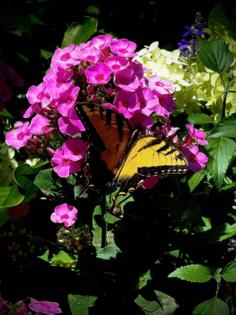On Gardening: Prismatic Pink phlox is a Luminary in the pollinator garden
Published in Gardening News
This was a leap year for several of my Luminary tall garden phlox in more ways than one, as I’ll explain shortly.
For those newbies to the world of perennials, we always explain that in year one, they sleep. This means they are there and will bloom, but they are getting those roots established. Year two they creep, meaning they put on some width, or spread.
And in year three, they leap.
In the case of my Luminary Prismatic Pink phlox, I got the majestic bloom to about 3 feet in height. It has been a year of bloom, fragrance and butterflies. Can we say BINGO!
When you are on the three-year plan of sleep, creep and leap with perennials, and particularly if you want color and pollinators, your plan is built also on HOPE. This bed I am talking about is layered from front to back and segmented like a blooming overlapping calendar. The pollinator crescendo will begin at the end of August with the blooms of the Temple of Bloom Seven-Son Flower, which is a small tree.
This was a painfully slow butterfly year in the Columbus, Georgia, area. They showed up and with abundance, but some great pollinator plants had finished blooming by the time of their arrival. I’ve seen phlox wow with pollinators in years past, but this year will go down as extra special in what I call the driveway bed. At just the right time, Luminary Prismatic Pink lived up to its promise and bloomed in perfect coordination with Rockin’ Playin’ The Blues salvia and Miss Molly butterfly bush.
The front of the bed has Serendipity ornamental allium, Totally Stoked Riptide Stokes aster, and the Maestro agastache or hummingbird mints. I also have Crowning Glory Princess Bride and Purple Reign eucomis or pineapple lilies.
The Luminary Prismatic Pink phlox has brought in a variety of butterflies -- American Lady, Gulf Fritillary, Silver-spotted Skipper -- but the frequency of swallowtails has been something special
Tall garden phlox or summer phlox is known botanically as Phlox paniculata. Though they are native to 36 states, I have never seen one in the wild. The large number of states however is a key indicator of hardiness zones. This phlox is cold hardy in zones 3a to 8b
The prerequisites are sunlight and consistently moist but well-drained soil. Maintenance is easy. And it is magical; every year I finally reach a point where I am determined to deadhead, and just like magic they flush with another long period of bloom.
There are now 6 varieties in the Luminary series: Ultraviolet, Opalescence, Sunset Coral, Pink Lightning, Backlight and Prismatic Pink. They are all very close in size except for the white Backlight, which is just a little smaller.
They all bring to the garden a long period of bloom, fragrance and the ability to bring in bees, butterflies and hummingbirds. As we head toward September, we know that fall is a great time to plant perennials like Luminary phlox if your garden center or online source has some. They will get roots established for their coming out party in 2026.
In the meantime, follow me on Facebook @NormanWinterTheGardenGuy for more photos and garden inspiration.
____
(Norman Winter, horticulturist, garden speaker and author of “Tough-as-Nails Flowers for the South” and “Captivating Combinations: Color and Style in the Garden.” Follow him on Facebook @NormanWinterTheGardenGuy.)
(NOTE TO EDITORS: Norman Winter receives complimentary plants to review from the companies he covers.)
©2025 Tribune Content Agency, LLC













Comments